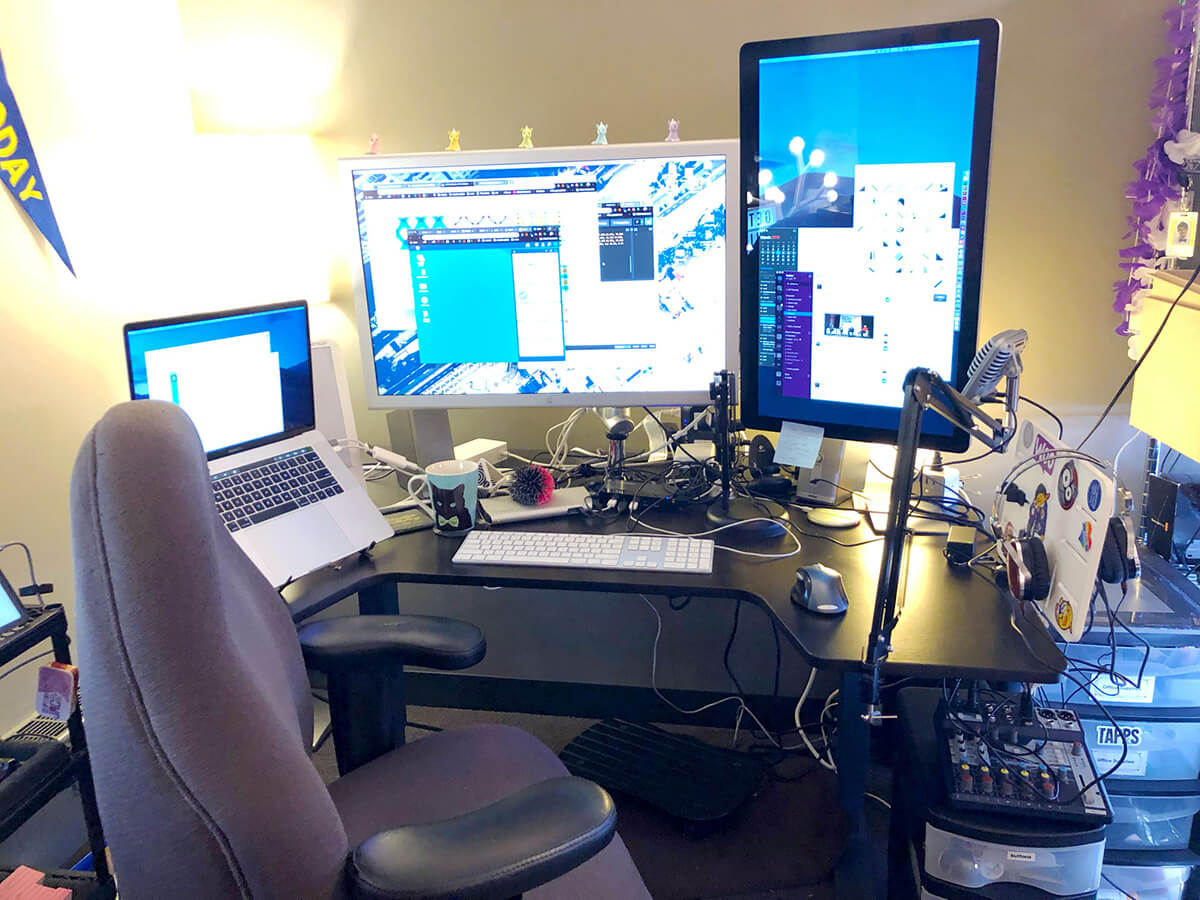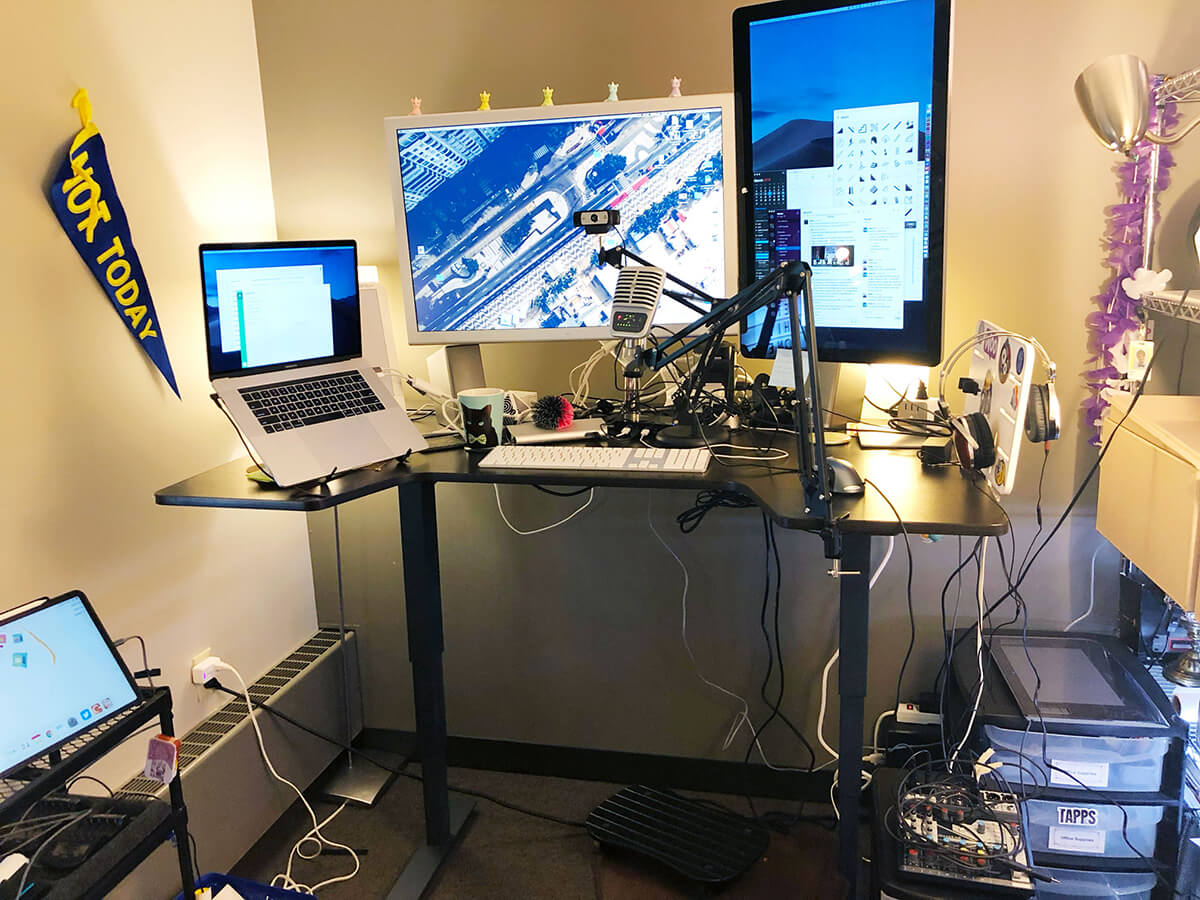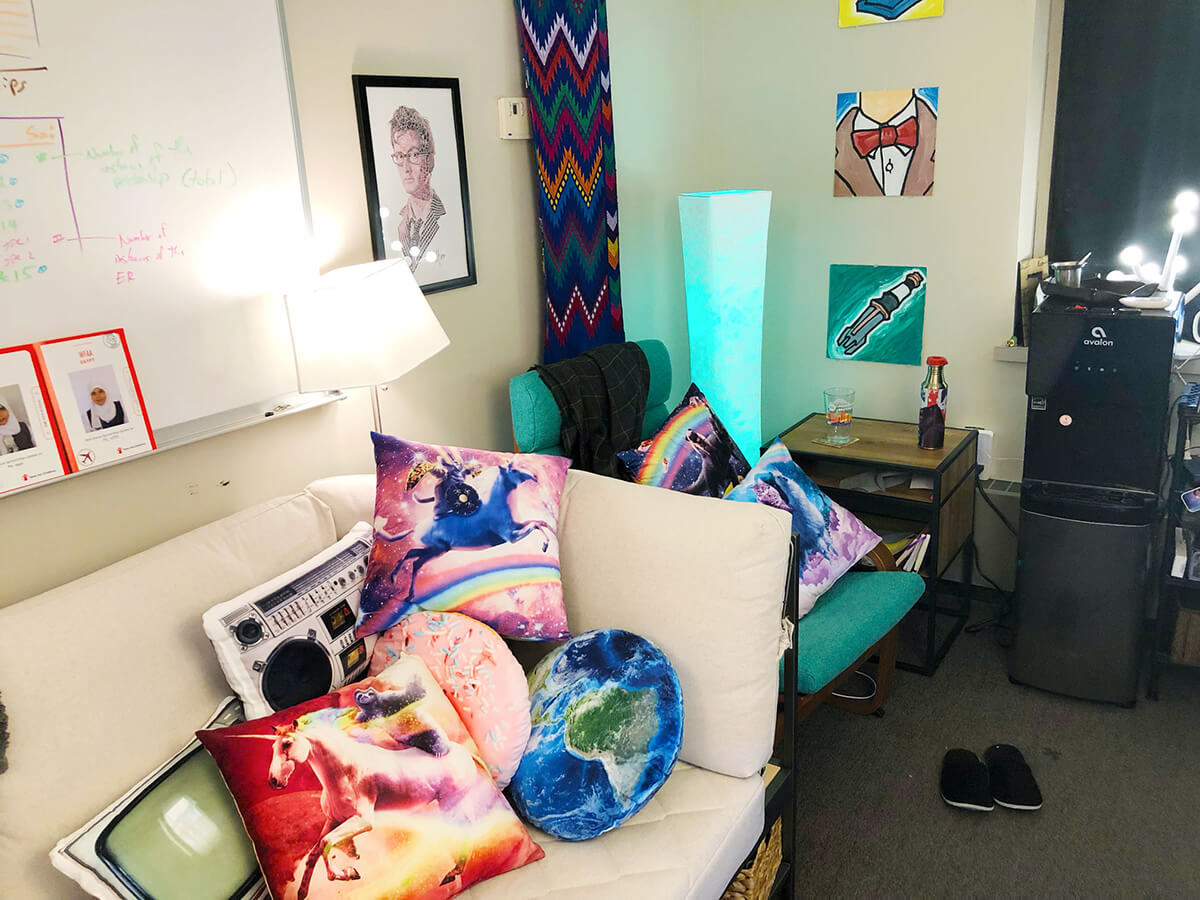How Freelancers Can Make the Most of Their Workspace With Tracy Apps
Our workspace has a big impact on our productivity. That’s important for freelancers because it’s all up to us. If you neglect to invest in your desk, computer, or virtual spaces, you simply won’t get as much done. But how do you maximize your workspace? Often it’s a matter of personal preference or work style.
Our workspace has a big impact on our productivity. That’s important for freelancers because it’s all up to us. If you neglect to invest in your desk, computer, or virtual spaces, you simply won’t get as much done.
But how do you maximize your workspace?
Often it’s a matter of personal preference or work style. Sometimes it’s a matter of trial and error. But it can also help to hear other people explain what works for them.
 So today we’re talking with Tracy Apps. She’s a veteran freelancer and a creative problem solver. Tracy does design, code, video, photography, strategy, social media, and more. She calls herself a “big picture do-er,” coming up with ideas and getting things done.
So today we’re talking with Tracy Apps. She’s a veteran freelancer and a creative problem solver. Tracy does design, code, video, photography, strategy, social media, and more. She calls herself a “big picture do-er,” coming up with ideas and getting things done.
 My desk is like my control center. I like to have everything I need visible and within reach. The same goes for my computer setup. My laptop and two large monitors allow me to spread out everything I need so I can access multiple windows and applications quickly and efficiently.
My desk is like my control center. I like to have everything I need visible and within reach. The same goes for my computer setup. My laptop and two large monitors allow me to spread out everything I need so I can access multiple windows and applications quickly and efficiently.
 Along the same lines, a few years after the chair, I purchased a hydraulic stand up/sit down desk from the same place. Using the two of these together has been a lifesaver. So I repeat: When you do this type of “desk” work, invest in your chair and desk.
Along the same lines, a few years after the chair, I purchased a hydraulic stand up/sit down desk from the same place. Using the two of these together has been a lifesaver. So I repeat: When you do this type of “desk” work, invest in your chair and desk.
 While I can get up and walk while sitting, I’m less likely to do so. But sometimes that is a good thing, like while doing a focused design or photo/video editing task. Sitting for those tasks not only helps with the focus I need, but also alleviates weight on my shoulders because the armrests of the chair, when properly positioned, support the weight of my arms completely. A sitting position also lends itself well for “leaning in” for close detail while standing helps me take a step back and evaluate the big picture.
My major tip for people is to find your own personal standing vs. sitting task divide. And don’t be afraid to break that when you need more energy (stand up) or more controlled calm (sit down).
While I can get up and walk while sitting, I’m less likely to do so. But sometimes that is a good thing, like while doing a focused design or photo/video editing task. Sitting for those tasks not only helps with the focus I need, but also alleviates weight on my shoulders because the armrests of the chair, when properly positioned, support the weight of my arms completely. A sitting position also lends itself well for “leaning in” for close detail while standing helps me take a step back and evaluate the big picture.
My major tip for people is to find your own personal standing vs. sitting task divide. And don’t be afraid to break that when you need more energy (stand up) or more controlled calm (sit down).

 So today we’re talking with Tracy Apps. She’s a veteran freelancer and a creative problem solver. Tracy does design, code, video, photography, strategy, social media, and more. She calls herself a “big picture do-er,” coming up with ideas and getting things done.
So today we’re talking with Tracy Apps. She’s a veteran freelancer and a creative problem solver. Tracy does design, code, video, photography, strategy, social media, and more. She calls herself a “big picture do-er,” coming up with ideas and getting things done.
“When you do this type of ‘desk’ work, invest in your chair and desk.” -Tracy AppsWe talk with Tracy about workspaces in several different areas, including the desk and physical workspace, computer setup, working on the go, and the virtual workspace.
Desk & Workspace
What does your desk setup look like?
 My desk is like my control center. I like to have everything I need visible and within reach. The same goes for my computer setup. My laptop and two large monitors allow me to spread out everything I need so I can access multiple windows and applications quickly and efficiently.
My desk is like my control center. I like to have everything I need visible and within reach. The same goes for my computer setup. My laptop and two large monitors allow me to spread out everything I need so I can access multiple windows and applications quickly and efficiently.
Is your desk messy or clean? How does that impact your work?
I would like to say that my desk is always clean. But it goes in waves. I get busy, my desk and surrounding shelves start becoming a bit more cluttered and unorganized. The more unorganized things get, the less I can focus. So there’s a tipping point when I cannot resist spending a few hours to clean and re-organize everything. Productive procrastination at it’s finest. Rinse and repeat.What tips do you have for boosting the productivity of your desk and workspace?
Streamline everything in the way that your brain and process works. You can Pinterest out your desk ’till you’re blue in the face… but if that doesn’t match up with how your brain is wired, it will do no good. I also recommend that you remain open to the idea that your organization and setup can change. I’ve added, removed, and changed almost everything at some point. Sometimes it was due to the nature of my work changing, sometimes it was just that I started feeling what used to work wasn’t working anymore. So I didn’t force it… I adapt my workspace to match. Plus, sometimes that means I get to buy fun colored storage boxes or shelves or lamps or office supplies… which I have learned I have a huge weakness for. It’s really just best to keep me away from Target, Office Depot, and the internet.Has anything with your desk setup had a substantial impact on your productivity?
My chair. I cannot stress enough how much investing in a good, quality, ergonomic chair is worth every penny, tenfold! At one point, my office chair was worth more than the car I was driving. I had only been self employed for a year or three, so it was a huge business expense for me at the time. But here we are, around 10 years later, and that office chair purchase is still paying off. With a history of back problems, this chair is one of the only places I can sit for hours and not be in pain. Along the same lines, a few years after the chair, I purchased a hydraulic stand up/sit down desk from the same place. Using the two of these together has been a lifesaver. So I repeat: When you do this type of “desk” work, invest in your chair and desk.
Along the same lines, a few years after the chair, I purchased a hydraulic stand up/sit down desk from the same place. Using the two of these together has been a lifesaver. So I repeat: When you do this type of “desk” work, invest in your chair and desk.
Any tips on using a standing desk?
Standing desks are great for some tasks, but not always the best for others. For example, any time I need to be active and alert, or have high energy while solving a complex problem, standing works best. Most all video conferences and recordings I do standing up. When I’m deep in problem solving mode, I stand, pace a bit, draw on the whiteboard, go back to the desk, etc. When my desk is in standing mode, I walk around a lot more—research has shown that this type of moving and pacing increases brain function and problem solving. While I can get up and walk while sitting, I’m less likely to do so. But sometimes that is a good thing, like while doing a focused design or photo/video editing task. Sitting for those tasks not only helps with the focus I need, but also alleviates weight on my shoulders because the armrests of the chair, when properly positioned, support the weight of my arms completely. A sitting position also lends itself well for “leaning in” for close detail while standing helps me take a step back and evaluate the big picture.
My major tip for people is to find your own personal standing vs. sitting task divide. And don’t be afraid to break that when you need more energy (stand up) or more controlled calm (sit down).
While I can get up and walk while sitting, I’m less likely to do so. But sometimes that is a good thing, like while doing a focused design or photo/video editing task. Sitting for those tasks not only helps with the focus I need, but also alleviates weight on my shoulders because the armrests of the chair, when properly positioned, support the weight of my arms completely. A sitting position also lends itself well for “leaning in” for close detail while standing helps me take a step back and evaluate the big picture.
My major tip for people is to find your own personal standing vs. sitting task divide. And don’t be afraid to break that when you need more energy (stand up) or more controlled calm (sit down).
Computer Setup
What computer setup do you have (desktop, laptop, dual monitors, etc.)?
I’ve got a MacBook Pro to the left of me, my 30-inch Apple Cinema Display front and center, and my second Apple Display (27-inch) rotated 90 degrees on the right.Why do you have your second monitor turned vertically?
The turned monitor I use mostly for a web browser with a site I am developing, and then Chrome Developer Tools panel below. I use some task runners in my development that auto refresh my site automatically on every save as I code. That is when I end up using the full height. If not developing, I use that screen to have my calendar and email off to the side—or look at long lists of files or spreadsheets.Are there any unique peripherals or tech toys you recommend?
The essentials are definitely a full-size keyboard, a mouse with extra buttons you can program (I have mine programed for copy and paste—and I use that a whole lot), and good speakers. I’ll admit, I’m a bit of an audiophile so I have multiple speaker options, as well as studio quality headphones within reach. Beyond the basics, I have a few different tablets (the older Wacom tablets, and similar products from other, not as well known companies) in my peripheral arsenal for photo editing work, an HD Logitech webcam (chosen specifically because it does well in low light) for video meetings/recording but also to live stream house concerts I’ve held in my living room, and a good quality USB mic (I recently upgraded from the blue yeti, to the Shure MV51 condenser mic) for meetings and podcasting. In addition to plenty of other charging docks and USB hubs, the other really important tool on my desk is my light therapy light box. sunlight is important to our brain’s chemistry, so sitting at a desk in an office all day can really take a toll on our mental health. I truly believe that having a full spectrum light box (one designed for mental health in particular) is a must in our line of work. I use my “happy light” quite a bit (let’s just say I’m on my second 10,000-hour bulb).Do you have any philosophy behind your setup and if so, how does that impact your productivity?
I have always been a lover of gadgets. This carries over into my work setup in a lot of ways. I know my ideal work area would be another person’s nightmare. I also like to surround myself with cute, colorful, quirky, humorous, nerdy, fun, and creative things. So in addition to lots of gadgets and tech equipment, you’ll also find Doctor Who artwork, a hula girl figurine, grumpy cat postcards, Legos, plenty of photos, magnetic blocks, stress balls that look like fruit, one of those “moo” cans (you know, you turn it over and it moos), and a couch filled with throw pillows in designs such as a boom box, a donut, or a laser cat holding tacos while riding a unicorn over a rainbow in space… you know, just your normal, run-of-the-mill pillows.
On the Go
When you work remotely or on the go, what are the must-have things to bring with you?
If I’m doing design work, I need at the very least an external mouse and keyboard. For trips longer than a few days I also bring a laptop stand and ergonomic seat cushions so I can have at least a semi-ergonomic workstation at a desk or table. For even longer trips, I will typically also pack my USB-powered external monitors, since I can fit two of those in a backpack carry-on, and while they’re not the highest quality, they at least help my productivity a bit by having that little extra screen real estate. If I’m not doing design or web development work on a trip, then I tend to rely mostly on my 12-inch iPad Pro, sometimes not even taking my laptop at all.Has the need for mobility changed your computer or desk setup?
Not really. Just has given me an excuse to buy more gadgets.Virtual Workspace
With so many digital things (emails, photos, files, etc.), sometimes it seems impossible to keep up. Is it worth organizing it? And if so, how do you do it?
I used to keep on top of backing up photos on external hard drives, uploading and geotagging photos on Flickr, and cleaning up my folders a lot more than I do now. Instead, now I automate as much as possible. Also, with the rise of online cloud storage services, I’m able to “set it and forget it” more when it comes to my digital life. After having some issues with computers and backup drives crashing or getting stolen altogether, I typically have my important files automatically synced to a couple places. For example, I save all my work files into my Dropbox folder directly. I pay for extra space so I can just store everything there. Then I can “selective sync” just my active client files to my laptop, unsync them from my laptop when not actively working with them to clear up hard drive space, and can always re-sync them when I need them again. I don’t save any files outside of my Dropbox folder, so if my computer ever crashes or I need to send it in for repairs, I don’t have to worry about losing any files because my backups are created automatically, in real time. Photos from my phone get automatically backed up to Dropbox, Flickr, and Amazon Photos. And then all these online backups also get synced to my RAID (redundant array of independent disks) NAS (network-attached storage) drive at home. As for organizing my more than 300,000 photos… I’m just gonna wait for photo recognition machine learning to get so good that I won’t have to worry about tagging and naming everything.Are you an inbox zero person?
I wish I was a inbox zero person. I do need notifications zero, or else I can’t focus on anything else. I do try to archive my several years old emails every year or so. But the temptation of ‘select all’ and ‘delete’ is great some days.Is there any philosophy behind how you setup your digital workspace? For example, back in the day I noticed Mac users would often name their hard drive while PC users didn’t. It’s a small thing, but it spoke to a certain personality that was at the heart of Apple’s philosophy.
Oh, I name everything! For example, my synology diskstation NAS drive is named “Syd,” when I got a shiny new MacBook Pro, I named the hard drive “Shinyface,” and typically my Apple products all are Tapps related (TappsBook Pro, TappsPad Pro, TappsPhoneX, etc.). I guess it all kinda falls under my love of personalizing everything. The back of my Prius is covered with stickers. My laptop is covered with stickers. My water bottle is covered with stickers. My TV stand table is covered with stickers and then epoxied. I’m an open book with a lot of my life, so maybe that’s why I like to display pieces of my personality on the outside of my “stuff.”Sign up now — Get SolidWP updates and valuable content straight to your inbox
Sign up
Placeholder text
Placeholder text
Get started with confidence — risk free, guaranteed